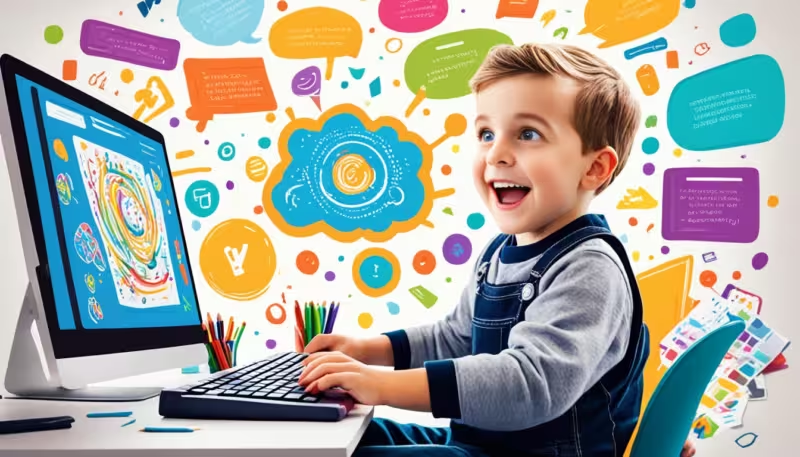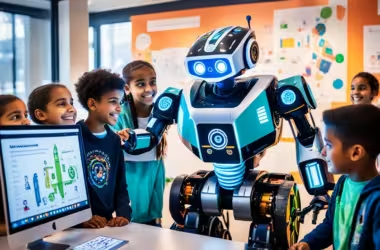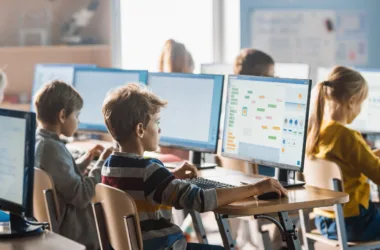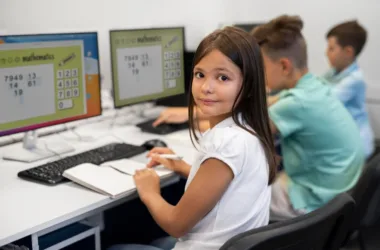Ever thought about how coding could change your child’s creative world? In today’s tech-forward society, coding for children is crucial. It’s not only about tech skills but also boosting creativity and thinking skills. This piece dives into how coding fuels creativity in kids. It also talks about why mixing coding with arts is key in today’s STEAM education.
Introduction to Coding and Creativity
Coding bridges the gap between tech and creativity, inspiring kids to unlock their imagination. It’s crucial for kids to grasp the basics of coding. This foundation is key for their growth and understanding coding.
Even kids as young as five can start coding. This early start boosts their creativity and tech skills. It taps into their curiosity, helping them innovate and solve problems better.
Learning to code is like learning a new language. Maria Klawe said, coding is today’s language of creativity. It shows coding’s role in boosting creative thinking.
Creative coding builds programming skills and opens up kids’ imaginations. It helps them see problems in different ways.
Research highlights coding’s benefits in education. For instance, a study with young kids showed coding helps with math and social skills. The 2019 State of Computer Science Education report shows more high schools teach computer science now. It proves these skills are more valued than ever in education.
Coding strengthens kids’ tech skills and encourages them to try new things, like Thomas Edison did. This mix of tech learning and creative thinking is vital. It helps kids thrive in a world driven by digital technology.
The Importance of STEAM Education
STEAM education is key to readying students for today’s complex issues. It blends science, technology, engineering, arts, and math for comprehensive learning. This mix boosts creativity and critical thinking.
What is STEAM Education?
During President Barack Obama’s time, the Every Student Succeeds Act made STEAM education a law in 2015. This approach encourages combining arts with STEM, enriching education. It emphasizes practical skills like social interaction and effective communication.
Benefits of Integrating Arts with STEM Fields
STEAM education comes with many pluses. It promotes collaborative learning and sparks creativity. Plus, it boosts social skills and offers diverse educational tools.
By joining arts with science and math, students enhance their problem-solving abilities. Studies prove these students better handle life’s challenges. They perform well in science and literacy, showing STEAM’s power in driving educational innovation.
Coding Enhances Creativity in Kids
Coding lets kids explore and grow their creative thinking. It connects their imagination with the real world. This encourages them to come up with unique solutions. Coding also promotes innovation, making kids think deeply as they work on projects. This builds their confidence.
How Coding Encourages Innovative Thinking
Learning to code boosts logic and reasoning in kids. It helps them visualize and bring ideas to life. With platforms like Scratch and Code.org, kids dive into interactive coding projects. These enhance their imagination and typing skills, making them more accurate and faster. Steve Jobs said, “coding teaches you how to think,” showing its cognitive benefits.
Real-World Applications of Creative Coding
Creative coding lets kids turn their ideas into reality. They can code animations, design games, or program robots. These projects show how coding is used in the real world. They build technical skills and inspire kids to explore diverse career paths. By finishing these projects, kids see how their skills are used and learn about different coding jobs.
Building Problem-Solving Skills Through Coding
Coding is a great way to help kids get better at solving problems. They face coding challenges that make them break big problems into smaller parts. This helps them find solutions in a step-by-step way.
When kids program, they learn how to overcome obstacles. They do this by splitting tasks into smaller pieces and thinking analytically.
Bringing coding into learning has many benefits:
- It boosts kids’ critical thinking and organizational skills by teaching them how to sort information.
- It makes kids more creative by letting them brainstorm and try things over and over until they succeed.
- It encourages kids to look back at how they solve problems. Then, they can change their approaches for the better.
Through coding, kids learn the importance of keeping at it. They get better at spotting and fixing mistakes. This teaches them resilience and how to adjust to new situations. They also get better at working together on team projects. By taking on coding challenges, kids learn how to share ideas, plan, and solve disagreements. This prepares them for many jobs in the future.
Studies show that coding helps kids do better in school. For instance, kids who code often get higher marks in math. Coding from an early age also sets kids up for success in tech jobs. Groups like Codemasters highlight how important starting early with coding is.
As kids learn to code, they unlock their creativity and get really good at handling everyday challenges. Teaching kids coding is giving them a key skill for the digital age. This way, parents and teachers help kids succeed in tomorrow’s world.
Enhancing Critical Thinking with Coding
Coding is a great way to boost critical thinking in kids. It helps them break down big problems into smaller parts. This improves their coding and critical thinking skills. As they learn to analyze, question, and evaluate, their analytical skills grow. They also become more resilient, facing challenges and learning from mistakes in coding.
Encouraging Analytical Approaches
Developing analytical skills starts with understanding coding’s logic. Recognizing patterns and cause-and-effect in code teaches kids to think logically. They learn to look for multiple answers and not give up on tough challenges. Each code line is a chance to grow critical thinking, making kids independent problem solvers.
Understanding Complex Concepts through Code
Coding makes learning complex ideas like algorithms fun for kids. They get to create programs, boosting their creativity. This way, they become curious and keep exploring new ideas. Coding is an excellent tool for teaching, linking different subjects, and improving problem-solving skills. It helps in understanding coding and the surrounding world better.
Fostering Collaboration and Teamwork
Coding is a key way to help kids learn to work together. During educational projects, students often have to code in groups. They learn to share tasks and combine their ideas to meet a common goal.
Working on coding projects with others boosts social skills and readies kids for future jobs. Careers in software development and data science need people to collaborate. Coding teaches kids how to work well with others, a must-have skill for many tech careers.
Sites like Code.org and Scratch offer interactive coding lessons that emphasize working together. These platforms provide hands-on learning that captivates kids. JetLearn customizes its lessons to match every child’s interests, enhancing creativity, problem-solving, and teamwork.
Hands-On Learning Experiences with Coding
Hands-on learning is key to getting kids interested in coding. They dive into the digital world through fun coding projects. This approach boosts their creativity and teaches important skills. Plus, it makes learning fun and applies concepts in real ways.
Interactive Projects that Spark Imagination
Interactive coding lets kids bring their ideas to life. They create games or animations, seeing their visions take shape. Tools like Scratch and Tynker are great for young coders. Kids love trying new things with these projects, which ignites a love for learning.
How Coding Camps Enhance Engagement
Coding camps are perfect for hands-on learning. These camps, like summer programs, focus on team projects. They promote teamwork and creative problem-solving. For instance, Juni Learning provides awesome coding activities. These experiences sharpen thinking and logic skills. Kids learn coding deeply and enjoyably.
Preparing for Future Careers through Coding
The digital age has changed how we learn, making coding very important for kids. The tech industry is growing fast. Knowing how to code is key for kids to be ready for school and future jobs. Even children who are five or six can start learning coding. This helps them get ready for many different careers.
Coding helps kids think more logically and teaches them patience and perseverance. Kids who code usually do better in school, in all subjects, not just in science, technology, engineering, and math (STEM). Using platforms like Scratch, for children seven and older, or Tynker, which gives them special challenges, can help kids develop important skills for working.
- Coding in school courses makes kids more creative and better at solving problems.
- Learning coding languages like Java, Python, SQL, and C++ can lead to jobs in data science, web design, and creating software.
- Fun tools and games like LEGO Boost and Osmo’s Coding Starter Kit make learning to code enjoyable for kids.
Coding camps or online lessons can make kids love technology for their whole lives. These fun ways of learning help kids become strong and ready to solve hard problems. As technology becomes a bigger part of everything, knowing how to code opens up many career options for kids, like becoming a software developer or starting their own business.
Embracing Failure as a Learning Tool
Learning from failure is key in the growth of young coders. Coding helps kids see mistakes as chances to get better. Resilience in coding shows the need to adjust when faced with problems.
Kids are naturally adaptable, making them great at embracing resilience in coding. When their code doesn’t work, they learn to keep trying. This helps them become better at solving problems. By developing a growth mindset, children become more resilient.
- Building problem-solving skills: Debugging teaches kids to think critically and find solutions.
- Encouraging perseverance: Young coders stay dedicated, learning from bugs and errors.
- Seeking feedback: Working together, kids learn to seek and offer help, improving together.
Coding teaches kids to view failure as part of learning. It helps them learn to keep going after making mistakes. This shows the link between sticking with it and succeeding in coding. In a fun coding setting, children learn that challenges help them grow personally and at school.
Creating a Supportive Learning Environment at Home
Creating a great learning space at home can really help your child learn to code. It’s key to spark kids’ curiosity to keep them interested in coding. A tidy and welcoming study area is crucial. By adding art and photos, you can make this space reflect your child’s likes. This also shows that learning is important in a cozy and inspiring setting.
Encouraging Exploration and Curiosity
Helping kids make daily or weekly goals keeps them organized and on track. It teaches them to be responsible and feel proud of their achievements. Also, fun activities like coding games or hands-on projects make learning exciting. These help kids understand coding better and have fun at the same time.
Adding coding tools like Scratch for younger kids or Python for teens can really spark their interest. Coding toys, such as Botley the Coding Robot, provide a hands-on way to learn without screens. This is especially good for young children.
Resources for Parents to Support Coding Education
There are many helpful resources for parents to help their kids code. Here are some great options:
- Tynker – Offers over 5,000 coding activities to promote creativity and teamwork.
- Codemoji – Great for kids aged 5-13, teaching basic coding like HTML and CSS.
- Kodable – Has fun games for 4-11 year olds that teach coding basics.
- Vidcode – A platform for teens that blends coding with creativity.
- CodaKid – Known for teaching more than 50,000 kids and teens to code.
Setting up a good learning area and using these resources can support your child’s coding education. Doing regular coding activities as a family helps reinforce concepts and teamwork. It’s also important to stay positive about challenges, celebrate successes, and talk openly with teachers. This builds a supportive home learning environment.
Conclusion
Coding in education brings many benefits that help kids grow. It makes problem-solving and creativity better. Kids also learn more through fun, hands-on activities. Schools adding coding to their lessons see its value. It sparks curiosity and gets students ready for a digital future.
Young coding stars show us the bright future of coding education. Coding lets kids create digital solutions and tell stories with technology. Parents also help a lot by supporting and cheering on their child’s coding progress.
In a world where coding is key, early learning opens many doors. It leads to many job options and makes kids feel proud of their achievements. By supporting coding education, we’re helping grow future innovators who will change the world.






